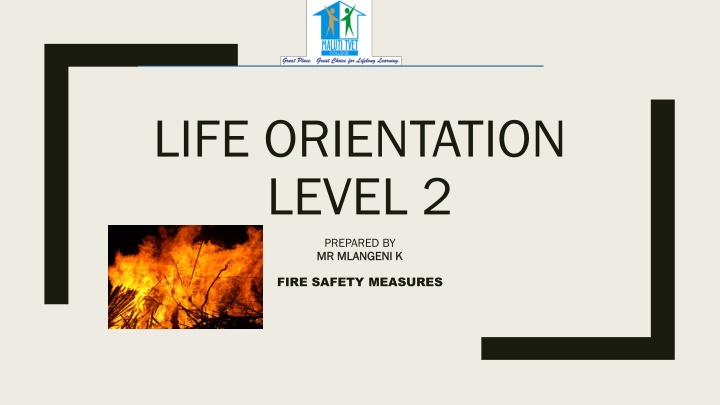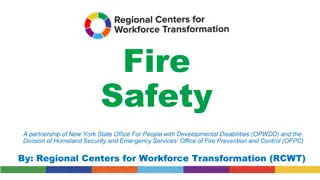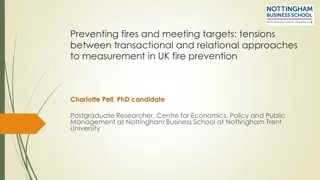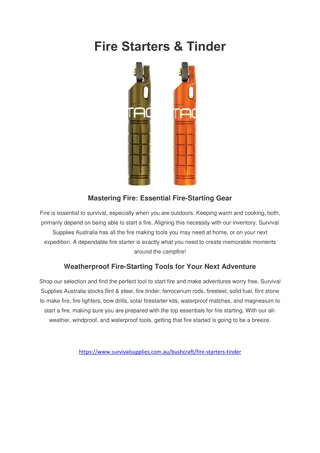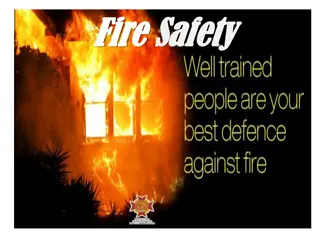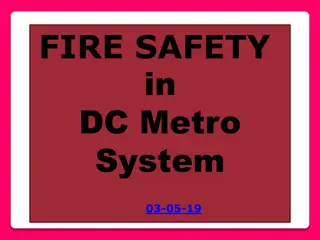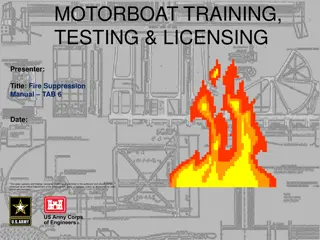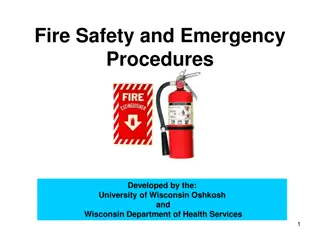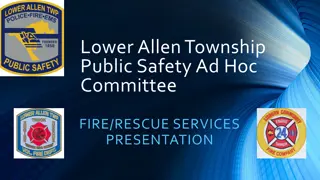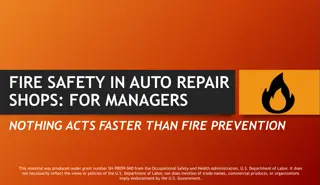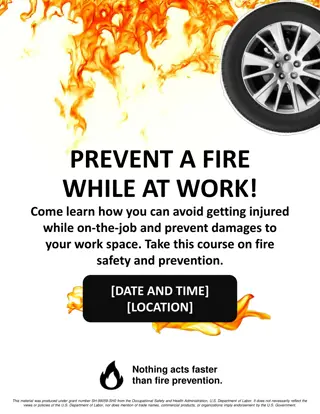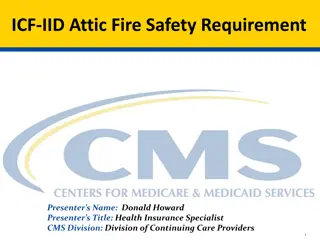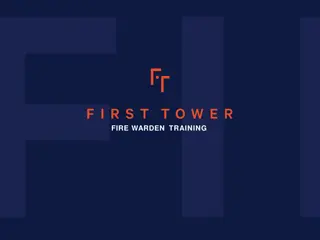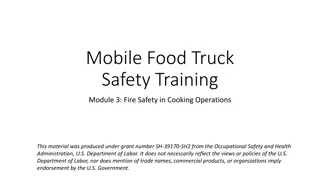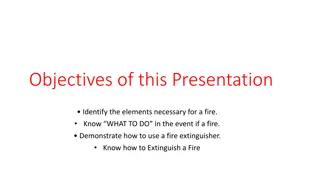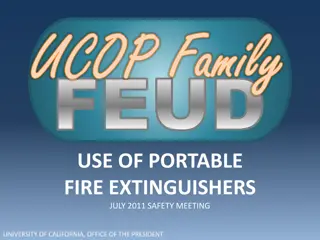Fire Safety Measures and Prevention Tips for Everyday Life
In this lesson prepared by Mr. Mlangeni K., you will learn about fire risks, prevention methods, handling fire emergencies, and providing basic first aid for burn victims. Explore common fire risks, causes, and practical tips to keep yourself and your surroundings safe from fire hazards.
Download Presentation

Please find below an Image/Link to download the presentation.
The content on the website is provided AS IS for your information and personal use only. It may not be sold, licensed, or shared on other websites without obtaining consent from the author.If you encounter any issues during the download, it is possible that the publisher has removed the file from their server.
You are allowed to download the files provided on this website for personal or commercial use, subject to the condition that they are used lawfully. All files are the property of their respective owners.
The content on the website is provided AS IS for your information and personal use only. It may not be sold, licensed, or shared on other websites without obtaining consent from the author.
E N D
Presentation Transcript
LIFE ORIENTATION LEVEL 2 PREPARED BY MR MLANGENI K MR MLANGENI K FIRE SAFETY MEASURES
After completing this lesson, you will be able to: Identify fire risks. Explain how to prevent fires. Describe what to do in a fire emergency. Describe basic first aid for burn victims.
What is a fire risk? A fire risk fire risk is a danger that a fire could start. Fire tarts when heat comes into contact with fuel and oxygen.
Common fire risks include: Anything that can start a fire. Anything that can burn a fire. Oxygen sources such as air conditioning. Examples: People use heaters and fires to stay warm when it is cold in winter. Alcohol abuse can result in careless behaviour near fire. Not all houses, institutions and place of work have smoke alarms. Children who play with matches.
Common causes 1. Cooking equipment Pots and pans can overheat and cause a fire very easily if the person cooking gets distracted and leaves cooking unattended. Always stay in the room, or ask someone to watch your food, when cooking on hotplates. 2. Heating Keep portable heaters at least one metre away from anything that could easily catch fire such as furniture, curtains, laundry, clothes and even yourself. If you have a furnace, get it inspected once a year to make sure it is working to safety standards. 3. Smoking in bedrooms Bedrooms are best to be kept off limits for smoking. A cigarette that is not put out properly can cause a flame, as the butt may stay alit for a few hours. It could burst into flames if it came into contact with flammable materials, such as furniture. Did you know that fires started in the bedroom or lounge make up 73% of all house fire fatalities?
4. Electrical equipment An electrical appliance, such as a toaster can start a fire if it is faulty or has a frayed cord. A power point that is overloaded with double adapter plugs can cause a fire from an overuse of electricity. A power point extension cord can also be a fire hazard if not used appropriately. Double check the appliances and power points in your home. 5. Candles Candles look and smell pretty, but if left unattended they can cause a room to easily burst into flames. Keep candles away from any obviously flammable items such as books and tissue boxes. Always blow a candle out before leaving a room. Did you know that in Perth last year 34 house fires started as a result of candles?
6. Curious children Kids can cause a fire out of curiosity, to see what would happen if they set fire to an object. Keep any matches or lighters out of reach of children, to avoid any curiosity turned disaster. Install a smoke alarm in your child s room and practice a home escape plan with your children and family in case there was a fire. Teach kids understand the stop, drop, cover and roll drill as well as knowing their address if they needed to call 000. 7. Faulty wiring Homes with inadequate wiring can cause fires from electrical hazards. Some signs to see if you ve bad wiring are: Lights dim if you use another appliance; For an appliance to work, you have to disconnect another; Fuses blow or trip the circuit frequently. Have a licenced electrician come and inspect you house, or contact your landlord if you have any of the above occurrences.
8. Barbeques Barbeques are great for an outdoor meal, but should always be used away from the home, tablecloths or any plants and tree branches. Keep BBQs regularly maintained and cleaned with soapy water and clean any removable parts. Check the gas bottle for any leaks before you use it each time. 9. Flammable liquids If you have any flammable liquids in the home or garage such as petrol, kerosene or methylated spirits, keep them away from heat sources and check the label before storing. Be careful when pouring these liquids. 10. Lighting Lamp shades and light fittings can build up heat if they are very close to light globes. Check around the house to make sure. Lamp bases can become a hazard if they are able to be knocked over easily, and so should be removed if they are. Check that down lights are insulated from wood panelling or ceiling timbers.
The main causes of fire in the workplace are: electricity neglect or misuse of wiring can lead to short circuits rubbish and waste material fire is likely to spread through accumulated waste smoking carelessly discarded cigarette butts or lit matches are one of the major causes of fire cooking kitchens provide opportunities for a fire to start and materials on which it can feed heating appliances portable heaters are a threat when placed beside combustible furniture or fittings combustible materials including - flammable liquids, glues and solvents are all liable to combust unless stored and used properly
Here are 10 ways to reduce the risk of house fires: 3. Keep Your Stove and Oven Clean 1. Test Your Smoke Alarms Regularly Don t worry, the stove didn t randomly combust because of your cooking. It most likely happened because forgotten food particles on the burner got too hot. Food particles aren t the only thing that could cause this to happen. The easiest way to avoid a house fire is by checking your smoke alarms regularly. There is a little button on it that you can press to test it. If it beeps weakly, then you need to change the batteries ASAP. If your curtains hang a little too close to the stove, they can catch fire. If you leave a dish towel or cookbook on a burner that you forgot was still hot, they can catch fire. If a fire breaks out and it s not working, tragedy can quickly occur as no one is alerted to evacuate. 4. Don t Leave Your Kitchen 2. Inspect All Your Heating Sources A few seconds is all it takes for a fire to break out. This is why you never want to leave cooking food unattended. If you have to leave the kitchen for any reason, turn off that pot of boiling noodles first. If your heating sources aren t working properly they could trigger a fire to happen. You should have them checked out annually by a professional. If for whatever reason you can t turn off the oven, call someone into the kitchen to watch the food until you get back. Make sure your air filters are always cleaned out, and if you re using a space heater it needs to be positioned away from anything flammable. A fire can easily start from debris and dust being too close to a heat source so make sure you clean them regularly.
5. Always Check Your Dryer 7. Properly Store Flammable Products Depending on what type of dryer you have, they need to be inspected on a yearly basis. We all get in a hurry when we re doing our chores but, don t forget to clean out your lint trap every time you put in a new load of laundry. Household cleaners and common cosmetic items like hairspray and shaving cream can be hazardous. If they are exposed to a large heat source, they can combust. You want to keep them away from space heaters, and store them safely in a cool area. You also want to check behind the machine to make sure lint or little clothing items like socks didn t manage to get back there. 8. Practice Caution with Candles Everyone loves scented candles, especially around the holidays but if you don t use them carefully, they could cause a fire. Make sure you put them out before you exit a room and keep them far away from blankets or other objects. 6. Maintain All Cords Before you plug something in, make sure that the cord hasn t been frayed or chewed. If you do notice damaged wires, replace them as soon as possible because this is a huge fire hazard. If you feel yourself drifting off to sleep, get up and blow the candle out. Never put them on an uneven surface like carpet, because it s too easy for them to tip over. If you have pets, make sure lit candles stay out of their reach. Also, check your cord placement. They tend to get hot so you want to avoid running them under a rug or between your wall and furniture.
9. Be Careful with Your Fireplace Every family member should know how to use an extinguisher so if a fire does happen, it can be put out as fast as possible. You don t want any stray sparks to escape so you need to make sure you have a door between the flames and your flooring. It goes without saying, but never leave the room when the fireplace is going. Only You Can Help Prevent House Fires There is nothing more devastating than losing everything you own to house fires. Your home is like a member of your family. It s where you make your most precious memories, so you owe it to yourself to protect it. When you throw the ashes away, make sure you ve given them more than enough time to cool down. Dispose of them in a metal container that is designated just for the ashes. 10. Keep Fire Extinguishers Around Fire extinguishers are your best defence weapon when a fire breaks out. You want to make sure you have one in every room that is a potential threat, such as the kitchen.
10 Ways You Can Prevent a Fire Today 1. Blow out candles before leaving a room or going to bed. 6. Have wood and coal stoves, fireplaces, chimneys, and furnaces professionally inspected and cleaned once a year. 2. When cooking, keep towels, pot holders and curtains away from flames. 7. Keep candles at least 12 inches away from anything that can burn such as bedding, curtains or clothing. 3. Keep matches, lighters and other ignitable substances in a secured location out of the reach of children, and only use lighters with child- resistant features. 8. Clean cooking surfaces on a regular basis to prevent grease build-up. 4. Hire a certified professional to inspect your chimney and heating equipment annually 9. Always check the kitchen before going to bed or leaving the home to make sure all stoves, ovens, and small appliances are turned off. 5. Keep fire in your fireplace by using a glass or metal fire screen large enough to catch sparks and rolling logs. 10. Keep all potential sources of fuel like paper, clothing, bedding or rugs at least three feet away from space heaters, stoves, or fireplaces.
Fire emergency What to Do in Case of a Fire Immediately pull the nearest fire alarm pull station as you exit the building. When evacuating the building, be sure to feel doors for heat before opening them to be sure there is no fire danger on the other side. If there is smoke in the air, stay low to the ground, especially your head, to reduce inhalation exposure. Keep on hand on the wall to prevent disorientation and crawl to the nearest exit. Once away and clear from danger, call your report contact and inform them of the fire. Go to your refuge area and await further instructions from emergency personnel.
What to do/what not to do in a fire emergency Do Do NOT Leave candles, incense, barbecue grills or other open flames unattended. (Note that these items are prohibited in University housing.) Know your building s evacuation plan. Evacuate calmly and quickly whenever a fire alarm or carbon monoxide alarm sounds. Use halogen lamps near curtains or other combustibles. (Halogen lamps are prohibited in University housing). Keep important items such as medications and medical equipment handy for quick access in the event of a building evacuation. Hang tapestries from walls or ceilings. Leave cooking appliances unattended. Know two ways out of any building. Use barbecue grills in or on any building or fire escape. Before opening a door, feel it with the back of your hand. If the door is hot, do not open it. Smoke in bed. (Smoking is prohibited in University housing). If you encounter smoke during your evacuation, stay low to the floor. Know the outside rally point for your building
Tamper with smoke detectors, carbon monoxide alarms, fire alarms or sprinkler systems. In case of a smoke or fire emergency, activate the nearest fire alarm pull station, alert those around you, and from a safe location call the fire department by dialling 911 Ignore any building alarm. Ensure that smoke and carbon monoxide alarms have batteries. Change the batteries (when you set your clocks back or forward. Hang anything from sprinkler heads or pipes. Test smoke and carbon monoxide alarms regularly. Foreign objects may impede the system s function. Make sure that hallways and stairway doors close tightly. Prop fire or smoke doors open. Know the locations of fire extinguishers, fire alarm pull stations, and exits. Use elevators during an evacuation. Learn to use a fire extinguisher. Extinguish barbecue coals completely.
First aid for burn injuries Protect your own safety at all times For all burns apply cold running (tap) water for at least 20 minutes If running water not available, wet 2 cloths and alternate them onto the burn every 2 minutes Keep the rest of the body warm Do NOT use ice, butter, creams, etc. Remove clothing and jewellery as they can hold heat on the burn and jewellery can stop blood flow to the burn. Seek medical attention for any burn bigger than a 20 cent coin, or that blisters or if there are any concerns. Ensure that all adults in the household know and understand proper first aid. Where appropriate, children should be taught general first aid principles.
An activity to do: List 3 fire risks Explain 5 ways in which fire can be prevented Activity 24-Page 155
EDUCATION IS THE MOVEMENT FROM DARKNESS TO LIGHT
